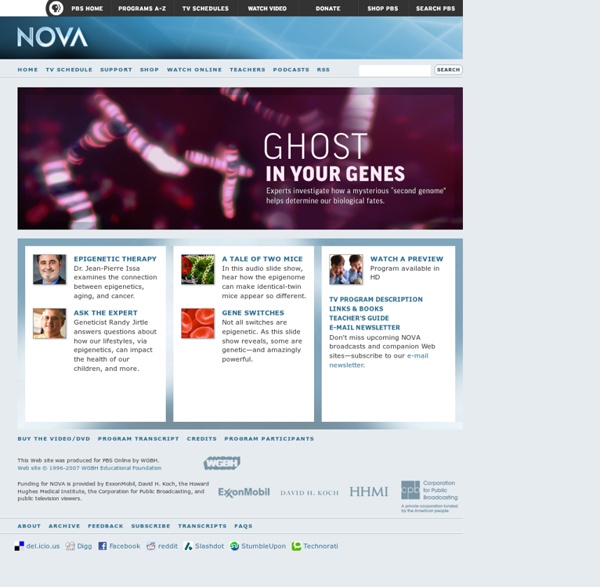



Cracking the Code of Life Cracking the Code of Life PBS Airdate: April 17, 2001 ROBERT KRULWICH: When I look at this—and these are the three billion chemical letters, instructions for a human being—my eyes glaze over. But when scientist Eric Lander looks at this he sees stories. ERIC LANDER (Whitehead Institute/MIT): The genome is a storybook that's been edited for a couple billion years. ROBERT KRULWICH: This is the story of one of the greatest scientific adventures ever, and at the heart of it is a small, very powerful molecule, DNA. For the past ten years, scientists all over the world have been painstakingly trying to read the tiny instructions buried inside our DNA. J. FRANCIS COLLINS (National Human Genome Research Institute): This is the ultimate imaginable thing that one could do scientifically...is to go and look at our own instruction book and then try to figure out what it's telling us. ROBERT KRULWICH: And what it's telling us is so surprising and so strange and so unexpected. I'm Robert Krulwich. DR.
Geniverse Research Overview Geniverse research is being led by our research partner, BSCS, with assistance from our evaluator partner, TERC. Our research study is examining how the Geniverse materials affect students’ genetics content knowledge and abilities to engage in scientific argumentation. The research study began in the fall of 2012 with 48 teachers. An added feature of our research design is the ability to avoid measuring implementation dip – that is, the effects of immature implementation often measured in randomized experiments. Student Outcome Measures Student Content Knowledge Our primary measure of student achievement employs two sets of test questions. For the proximal items, we looked closely at each Geniverse learning goal and activity, and developed or identified items that aligned with each. For the distal items, we are using an instrument by Tsui and Treagust (2010) designed to diagnose scientific reasoning in genetics. Motivation Argumentation Other Measures
National Center for Biotechnology Information The Blood Typing Game - about blood groups, blood typing and blood transfusions What happens if you get a blood transfusion with the wrong blood type? Even though a patient's own blood type is the first choice for blood transfusions, it's not always available at the blood bank. Try to save some patients' lives and learn about human blood types! Play the Blood Typing Game About this game Embed the Blood Typing Game onto your own web site or blog Swedish version of the game 2012 Winner of the Best Game Category by Swedish Learning Awards "The winner has created a minimalistic but, at the same time, captivating graphic design which grabs the user's curiosity. See a Video about the Blood Typing Game 3 min. 1. ploster34802. Listed are players who have the highest number of treated patients within the last 24 hours.
New Genetic Twist: 4-Stranded DNA Lurks in Human Cells Sixty years after scientists described the chemical code of life — an interweaving double helix called DNA — researchers have found four-stranded DNA is also lurking in human cells. The odd structures are called G-quadruplexes because they form in regions of deoxyribonucleic acid (DNA) that are full of guanine, one of the DNA molecule's four building blocks, with the others being adenine, cytosine, thymine. The structure comprises four guanines held together by a type of hydrogen bonding to form a sort of squarelike shape. (The DNA molecule is itself a double strand held together by these building blocks and wrapped together like a helix.) The new visualization of the G-quadruplex is detailed this week in the journal Nature Chemistry. "I think this paper is important in showing directly the existence of this structure in vivo in the human genome, but it is not completely unexpected," said Hans-Joachim Lipps, of the University of Witten in Germany, who was not involved in the study.
Study of Holocaust survivors finds trauma passed on to children's genes | Science Genetic changes stemming from the trauma suffered by Holocaust survivors are capable of being passed on to their children, the clearest sign yet that one person’s life experience can affect subsequent generations. They also analysed the genes of their children, who are known to have increased likelihood of stress disorders, and compared the results with Jewish families who were living outside of Europe during the war. “The gene changes in the children could only be attributed to Holocaust exposure in the parents,” said Yehuda. Her team’s work is the clearest example in humans of the transmission of trauma to a child via what is called “epigenetic inheritance” - the idea that environmental influences such as smoking, diet and stress can affect the genes of your children and possibly even grandchildren. The idea is controversial, as scientific convention states that genes contained in DNA are the only way to transmit biological information between generations.
Teach.Genetics™ Air Pollution Causes Epigenetic Changes That May Trigger Asthma Once Nadeau understood the role of the methyl groups in gene expression, all the dots began to connect. She believed that air pollution triggered asthma in her Fresno patients by tagging Foxp3 in immature T cells with methyl groups, switching off its expression. This prevents the cells from maturing into those police officer T-regs that hold T helper cells in check. More exposure to pollution, then, would mean more methyl groups. As it turned out, Foxp3 bore the fewest methyl groups in Palo Alto children without asthma, and more in Palo Alto children with the disease. Nadeau and Tager published their results in the Journal of Allergy and Clinical Immunology in 2010. Smoke Screen Nadeau’s findings revealed that pollution could cause asthma by altering our biology at a fundamental level, changing how our very genes behave. Nadeau wanted to examine how air pollution and secondhand smoke — both linked to asthma — spurred epigenetic changes to Foxp3.
Personal Genetics Education Project